最新七年级英语语法汇总
七年级英语语法知识总结(10篇)
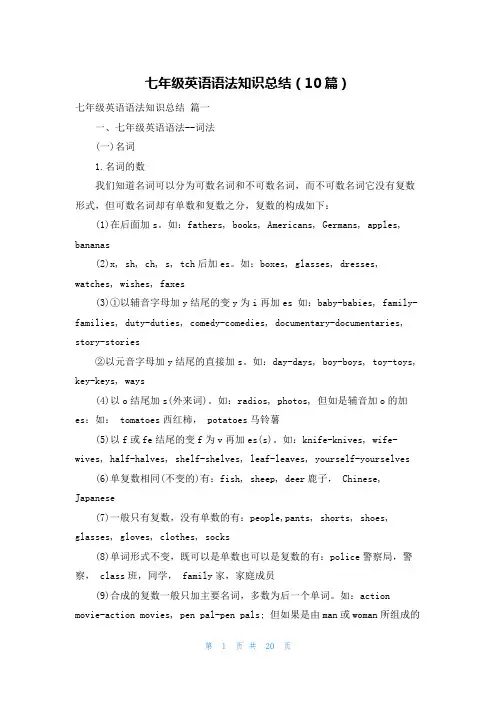
七年级英语语法知识总结(10篇)七年级英语语法知识总结篇一一、七年级英语语法--词法(一)名词1.名词的数我们知道名词可以分为可数名词和不可数名词,而不可数名词它没有复数形式,但可数名词却有单数和复数之分,复数的构成如下:(1)在后面加s。
如:fathers, books, Americans, Germans, apples, bananas(2)x, sh, ch, s, tch后加es。
如:boxes, glasses, dresses, watches, wishes, faxes(3)①以辅音字母加y结尾的变y为i再加es 如:baby-babies, family-families, duty-duties, comedy-comedies, documentary-documentaries, story-stories②以元音字母加y结尾的直接加s。
如:day-days, boy-boys, toy-toys, key-keys, ways(4)以o结尾加s(外来词)。
如:radios, photos, 但如是辅音加o的加es:如: tomatoes西红柿, potatoes马铃薯(5)以f或fe结尾的变f为v再加es(s)。
如:knife-knives, wife-wives, half-halves, shelf-shelves, leaf-leaves, yourself-yourselves (6)单复数相同(不变的)有:fish, sheep, deer鹿子, Chinese, Japanese(7)一般只有复数,没有单数的有:people,pants, shorts, shoes, glasses, gloves, clothes, socks(8)单词形式不变,既可以是单数也可以是复数的有:police警察局,警察, class班,同学, family家,家庭成员(9)合成的复数一般只加主要名词,多数为后一个单词。
最新人教版七年级英语语法知识点汇总
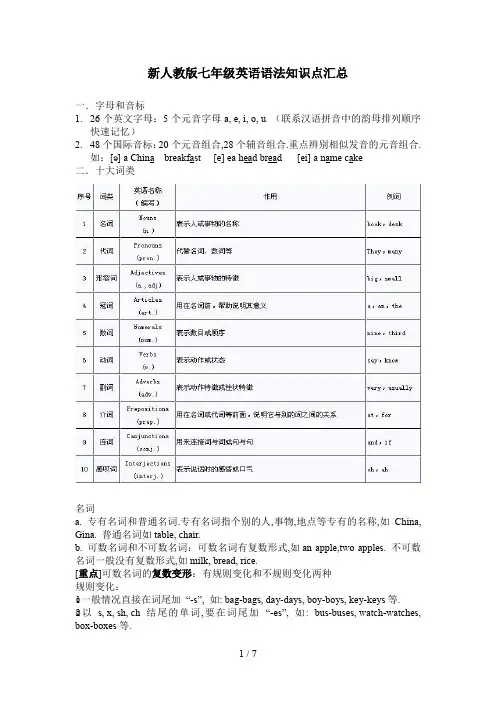
新人教版七年级英语语法知识点汇总一.字母和音标1.26个英文字母:5个元音字母a, e, i, o, u (联系汉语拼音中的韵母排列顺序快速记忆)2.48个国际音标:20个元音组合,28个辅音组合.重点辨别相似发音的元音组合.如:[ə] a China breakfast [e] ea head bread [ei] a name cake二.十大词类名词a. 专有名词和普通名词.专有名词指个别的人,事物,地点等专有的名称,如China, Gina. 普通名词如table, chair.b. 可数名词和不可数名词:可数名词有复数形式,如an apple,two apples. 不可数名词一般没有复数形式,如milk, bread, rice.[重点]可数名词的复数变形:有规则变化和不规则变化两种规则变化:○1一般情况直接在词尾加“-s”, 如: bag-bags, day-days, boy-boys, key-keys等.○2以s, x, sh, ch结尾的单词,要在词尾加“-es”, 如: bus-buses, watch-watches, box-boxes等.○3以辅音字母加y结尾的单词,要变y为i再加“-es”, 如:baby-babies, country-countries, family-families等.○4部分以f (e)结尾的单词,要变f (e)为“ves”, 如:knife-knives, half-halves等.顺口溜:小偷(thief)的妻子(wife),为了自己(self)保命(life),站到架子上(shelf),用树叶(leaf)做的小刀(knife),将狼(wolf)劈成了两半(half)○5以字母“o”结尾的单词,没有生命的加“-s”,有生命的加“-es”,如:zoo-zoos, photo-photos, tomato-tomatoes.口诀:黑人(Negro)英雄(hero)爱在火山(volcano)吃土豆(potato)西红柿(tomato)不规则变化:○1改变单数名词中的元音字母:man-men, woman-women, foot-feet, tooth-teeth等. ○2单、复同形:sheep-sheep, Chinese-Chinese, Japanese-Japanese等.○3其他形式如: mouse-mice, child-children等.c. 名词所有格:表示所属关系1. 单数名词词尾直接加’s, 复数名词词尾没有s的也要加’s, 如the boy’s bag 男孩的书包 men’s room 男厕所Children’s Day 儿童节2. 若是复数名词词尾有s ,只加“’”, 如:Teachers’ Day 教师节3. 如果两个名词并列,并且分别有’s,则表示“分别有”;只有一个’s,则表示“共有”,如:John’s and Mary’s room(两间) John and Mary’s room(一间)冠词1.定冠词the:特指某(些)人或某(些)物,如The blue shirt is mine. 蓝衬衫是我的.2.不定冠词a/an: 用来表示“一”这个数量, 其中an放在元音字母开头的名词前面,如an apple, an orange.3.零冠词: 不用冠词的情况.在专有名词,不可数名词,学科名称,三餐和球类运动名称前不用冠词,如:Tian’an Men Square天安门广场I have lunch at school every day.代词(人称、物主、反身代词)物主代词:包括名词性物主代词和形容词性物主代词.前者用法相当于名词,在句中可单独使用,如:--Who’s book is this? --It is mine. 后者用法相当于形容词,在句中不可单独使用,如It is my book.反身代词:表示“自己”,“本身”.指示代词数词1.基数词:表示数目的多少2.序数词:表示事物的先后顺序,往往与冠词the连用基数词变序数词口诀:一、二、三,单独记;八去t,九除e, ve要用f替,整十基数变序数,先把ty变成tie;要是遇到两位数,十位基数个位序,th最后加上去.口诀解析:one→first, two→second, three→third这三个词变化特殊,要单独记;eight →eighth, nine→ninth, 八去t,九去e后再加-th; five→fifth, twelve→twelfth,五和十二把ve换成f再加-th;twenty→twentieth, thirty→thirtieth... 整十先把词尾y改为ie再加-th.两位数时则十位数用基数词,个位数用序数词,如:twenty-first.注:four→fourteen→forty(基数词)fourth→fourteenth→fortieth(序数词)三.时态:一般现在时:a.表示习惯性、经常性、反复性的动作或存在的状态b. 表示事实或客观真理.结构:1. be动词(am, is, are)的用法记忆口诀:“我”用am, “你”用are, is用于“他、她、它”;单数全都用is,复数全部都用are.句子转换:当句子中有be动词或情态动词时,则把be动词或情态动词(can, could 等等)提到主语的前面变成一般疑问句;在be动词或情态动词后面加not变成否定句陈述句:She is a student. 一般疑问: Is she a student? 否定句:She is not a student.2. 实义动词do(除第三人称单数外,谓语动词用原形)句子转换:当句子中既没有be动词,也没有情态动词时,则在主语前加助动词do (I, you, we, they), does(单数she, he, it)变成一般疑问句;在主语后谓语动词前加助动词don’t(I, you, we, they), doesn’t(单数she, he, it)变成否定句,助动词后的动词要变成动词原形.陈述句:We get up at 7:00 every morning.一般疑问句:Do you get up at 7:00 every morning?否定句:We don’t get up at 7:00 every morning.【重点】动词第三人称单数(三单)的规则变化1. 一般在词尾加-s,如: looks, puts, reads, sees等.2. 以-o, -s, -x, -sh, -ch结尾的加-es,如: goes, does, watches, teaches3. 以辅音字母加y结尾的,变y为i再加-es. 注:若是元音字母加y,则直接加-s. 如:fly → flies, try → tries, fry → fries, copy → copiesbuy → buys, enjoy → enjoys, play → plays, say → says, pay → pays总结:三单的变化规律与可数名词复数的(前三种)变化规律相似.现在进行时:1.表示现在(说话的瞬间)正在进行或发生的动作,强调“此时此刻”.如:He is reading . They are talking now.2.表示当前一段时间内的活动或现阶段正在进行的动作.如:They are working on a farm these days.3. 结构:动词be(am/is/are)+V-ingV-ing形式构成:1. 一般在动词词尾加上-ing,如go→going look→looking watch→watching2. 以不发音字母e结尾的动词,先去e,再加-ing. 如write→writing take→taking3. 以重读闭音节结尾,且末尾只有一个辅音字母时,要先将词尾的辅音字母双写再加ing,如run→running shop→shopping get→getting sit→sitting一般过去时:表示过去某个时间里发生的动作或状态;或过去习惯性、经常性的动作、行为(used to);1.句子转换口诀:一般过去并不难,表示过去(动作、状态)记心间. 动词要用过去式,时间状语句末站.否定句很简单,didn't动词(原形)前,其它部分不要变.疑问句也好变,did放在句子前,其它部分依次站.陈述句He(she, it) worked 疑问句Did he(she, it) work?否定句He (she, it)did not work2. 表过去的时间状语如:ago, yesterday, the day before yesterday, last week, last (year, night, month, 具体时间), just now, at the age of , one day, long ago, once upon a time(很久以前)3. 动词变化规则:规则变化:a.一般情况直接加ed,如:work→worked look→lookedb. 以不发音的e结尾的,加-d,如:live →lived hope →hopedc. 以辅音字母+y结尾的,变y为i加ed, 如:study→ studiedd. 以重读闭音节结尾的,末尾只有一个辅音字母,要双写最后的辅音字母加-ed,如: stop→ stopped plan→planned不规则变化:过去时和原形相同, 如:cut→cut read→read四.There be句型结构1. 结构的主谓一致.There is/are+某物/某人+某地/某时表示某地或某时存在某事或某人.句子的结尾往往带有地点状语或时间状语.其中there是引导词,本身没有词意,be是谓语动词,be后面的名词是主语.be的数与后面的名词一致,若be后是两个或多个并列的名词,be则与靠得最近的那个名词的数一致.如There was a meeting yesterday. 昨天有个会议比较:There is a pen, two books and many pencils on the desk. 桌上有一支钢笔、两本书和好些铅笔.There are two books, a pen and many pencils on the desk2.there be的否定、疑问及其回答式(1) 否定式:be后面加not(any)或no.如:There are not any boats on the river. 河上没有船.(2) 疑问句:把be移到there之前.如:Were there many boats on this river? 过去这条河上有许多船吗?回答:Yes, there were. / No, there weren’t.五.句子种类祈使句:表命令、警告、提醒、建议、请求、叮嘱、号召等,谓语动词用原形.主语you通常省略,句末用叹号或句号.肯定式以动词原形开头,否定式在动词原形前加don’t. 如:Don’t arrive late for class. Practice the guitar every day.为了表示礼貌,常在句首或者句末加please,在句末以“,”隔开.如:n,please. Please call me!Let’s祈使句: 包括听话者本人在内,表示建议.如:Let’s go home. 我们回家吧!一般疑问句及特殊疑问句1、一般疑问句:能用Yes或No来回答的问句.一般疑问句句尾读升调.Is he a teacher? Yes, he is./ No, he isn’t.2、特殊疑问句:不能用Yes或No来回答的问句,句尾读降调.(由五个W一个H来引导特殊疑问句)–How was your trip? –It was great.–Where’s Gina? –She is in the teacher’s office.六.情态动词:是一种本身有一定的词义,表示说话人的情绪,态度或语气的动词,但不能单独作谓语,只能和其他动词原形构成谓语.can的基本用法:1.表示能力.I can speak English. 我会讲英语.2.表示许可.You can play football on weekends. 你可以在周末踢足球.3.表示请求.Can you help me? 你能帮助我吗?must表示“必须”. You must read a book before you watch TV.have to表示“不得不”,“必须”,如We have to be quiet in the library.二者区别:1. must表示说话人主观的看法,have to往往强调客观需要.如:I must go.It is a little late and I have to go now.2.否定意义不同:mustn’t 表示“禁止”,而don’t have to 表示“不必”.You mustn’t talk to your mother like that.You don’’t want to.3.must 没有人称和数的变化,但have to有I/You/They must do it now.She has to finish her homework today.八.介词介词是一种虚词,它不能单独担任句子成分,必须与名词或代词或相当于名词的其他词类、短语或从句构成介词短语,才能担任句子成分.1. 表示时间的介词at,in,onA. at:用于表示时刻、时间的某一点at 6 o’clock 在6点at lunch在午饭时at breakfast早餐时at noon正午时at that time那时B. on用于表示某天,某一天的上、下午(指具体的某一天,一律用on)on Monday在周一on Tuesday morning在周二早上 on June 6 在6月6日C. in用于表示周、月、季节、年和泛指的上午、下午、晚上(指在一段时间内)in the afternoon在下午in the week在这周in the holiday在假期中D. for 后面跟一段时间:for two days/hours2. 表示场所、方向的介词at,in,onA.at在某地(表示比较狭窄的场所, 小地方) at school上学at home在家B. on在...上面,有接触面on the desk 在桌子上面on the map在地图上C.in表示一个范围(大地方)in Beijing/China in the water3.固定搭配By+交通工具by bus/ train/plane/bike/subway重点:动词和介词的连用,如:arrive at/in 到达ask for 请求get off 下车listen to 听help sb with sth 帮助某人做某事talk about 谈论look at 看;注视。
七年级英语全部语法
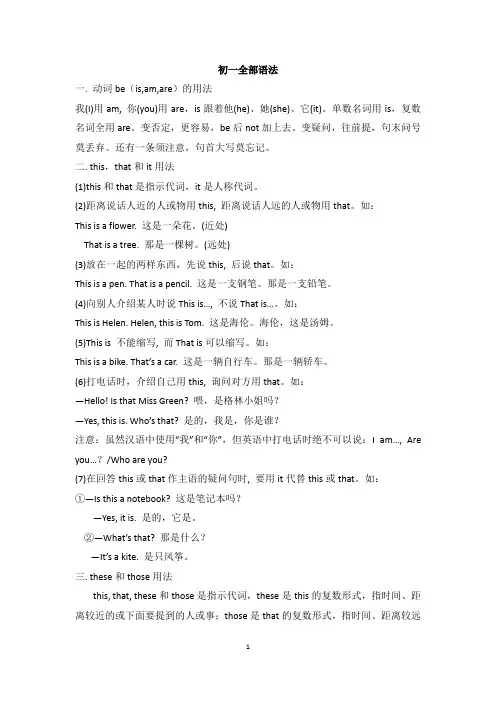
初一全部语法一. 动词be(is,am,are)的用法我(I)用am, 你(you)用are,is跟着他(he)、她(she)、它(it)。
单数名词用is,复数名词全用are。
变否定,更容易,be后not加上去。
变疑问,往前提,句末问号莫丢弃。
还有一条须注意,句首大写莫忘记。
二. this,that和it用法(1)this和that是指示代词,it是人称代词。
(2)距离说话人近的人或物用this, 距离说话人远的人或物用that。
如:This is a flower. 这是一朵花。
(近处)That is a tree. 那是一棵树。
(远处)(3)放在一起的两样东西,先说this, 后说that。
如:This is a pen. That is a pencil. 这是一支钢笔。
那是一支铅笔。
(4)向别人介绍某人时说This is…, 不说That is…。
如:This is Helen. Helen, this is Tom. 这是海伦。
海伦,这是汤姆。
(5)This is 不能缩写, 而That is可以缩写。
如:This is a bike. That’s a car. 这是一辆自行车。
那是一辆轿车。
(6)打电话时,介绍自己用this, 询问对方用that。
如:—Hello! Is that Miss Green? 喂,是格林小姐吗?—Yes, this is. Who’s that? 是的,我是,你是谁?注意:虽然汉语中使用“我”和“你”,但英语中打电话时绝不可以说:I am…, Are you…?/Who are you?(7)在回答this或that作主语的疑问句时, 要用it代替this或that。
如:①—Is this a notebook? 这是笔记本吗?—Yes, it is. 是的,它是。
②—What’s that? 那是什么?—It’s a kite. 是只风筝。
三. these和those用法this, that, these和those是指示代词,these是this的复数形式,指时间、距离较近的或下面要提到的人或事;those是that的复数形式,指时间、距离较远或前面已经提到过的人或事物。
七年级英语语法大全(动词、名词所有格,一般现在时)
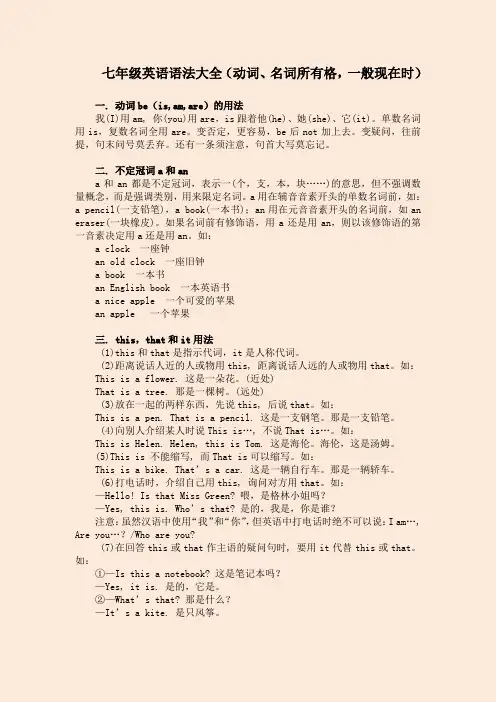
七年级英语语法大全(动词、名词所有格,一般现在时)一. 动词be(is,am,are)的用法我(I)用am, 你(you)用are,is跟着他(he)、她(she)、它(it)。
单数名词用is,复数名词全用are。
变否定,更容易,be后not加上去。
变疑问,往前提,句末问号莫丢弃。
还有一条须注意,句首大写莫忘记。
二. 不定冠词a和ana和an都是不定冠词,表示一(个,支,本,块……)的意思,但不强调数量概念,而是强调类别,用来限定名词。
a用在辅音音素开头的单数名词前,如:a pencil(一支铅笔),a book(一本书);an用在元音音素开头的名词前,如an eraser(一块橡皮)。
如果名词前有修饰语,用a还是用an,则以该修饰语的第一音素决定用a还是用an。
如:a clock 一座钟an old clock 一座旧钟a book 一本书an English book 一本英语书a nice apple 一个可爱的苹果an apple 一个苹果三. this,that和it用法(1)this和that是指示代词,it是人称代词。
(2)距离说话人近的人或物用this, 距离说话人远的人或物用that。
如:This is a flower. 这是一朵花。
(近处)That is a tree. 那是一棵树。
(远处)(3)放在一起的两样东西,先说this, 后说that。
如:This is a pen. That is a pencil. 这是一支钢笔。
那是一支铅笔。
(4)向别人介绍某人时说This is…, 不说That is…。
如:This is Helen. Helen, this is Tom. 这是海伦。
海伦,这是汤姆。
(5)This is 不能缩写, 而That is可以缩写。
如:This is a bike. That’s a car. 这是一辆自行车。
那是一辆轿车。
(6)打电话时,介绍自己用this, 询问对方用that。
最全七年级英语语法知识点汇总
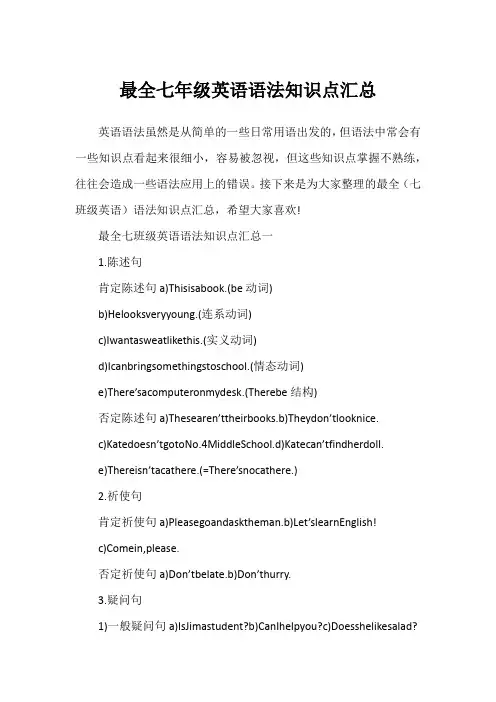
最全七年级英语语法知识点汇总英语语法虽然是从简单的一些日常用语出发的,但语法中常会有一些知识点看起来很细小,容易被忽视,但这些知识点掌握不熟练,往往会造成一些语法应用上的错误。
接下来是为大家整理的最全(七班级英语)语法知识点汇总,希望大家喜欢!最全七班级英语语法知识点汇总一1.陈述句肯定陈述句a)Thisisabook.(be动词)b)Helooksveryyoung.(连系动词)c)Iwantasweatlikethis.(实义动词)d)Icanbringsomethingstoschool.(情态动词)e)There’sacomputeronmydesk.(Therebe结构)否定陈述句a)Thesearen’ttheirbooks.b)Theydon’tlooknice.c)Katedoesn’tgotoNo.4MiddleSchool.d)Katecan’tfindherdoll.e)Thereisn’tacathere.(=There’snocathere.)2.祈使句肯定祈使句a)Pleasegoandasktheman.b)Let’slearnEnglish!c)Comein,please.否定祈使句a)Don’tbelate.b)Don’thurry.3.疑问句1)一般疑问句a)IsJimastudent?b)CanIhelpyou?c)Doesshelikesalad?d)DotheywatchTV?e)Isshereading?肯定回答:a)Yes,heis.b)Yes,youcan.c)Yes,shedoes.d)Yes,theydo.e)Yes,sheis.否定回答:a)No,heisn’t.b)No,youcan’t.c)No,shedoesn’t.d)No,theydon’t.e)No,shei sn’t.2)选择疑问句Isthetablebigorsmall?回答It’sbig./It’ssmall.3)特殊疑问句①问年龄HowoldisLucy?Sheistwelve.②问种类Whatkindofmoviesdoyoulike?Ilikeactionmoviesandcomedies.③问身体状况Howisyouruncle?Heiswell/fine.④问方式Howdo/canyouspellit?L-doubleO-K.Howdowecontactyou?Mye-*******************************.⑤问原因Whydoyouwanttojointheclub?⑥问时间What’sthetime?(=Whattimeisit?)It’saquartertotena.m..Whattimedoyouusuallygetup,Rick?Atfiveo’clock.Whendoyouwanttogo?Let’sgoat7:00.⑦问地方Where’smybackpack?It’sunderthetable.⑧问颜色Whatcolorarethey?Theyarelightblue.What’syourfavouritecolor?It’sblack.⑨问人物Who’sthat?It’smysister.Whoistheboyinblue?Mybrother.Whoisn’tatschool?PeterandEmma.WhoareLisaandTimtalkingto?⑩问东西What’sthis/that(inEnglish)?It’sapencilcase.Whatelsecanyouseeinthepicture?Icanseesomebroccoli,strawberriesandh amburgers.11问姓名What’syouraunt’sname?HernameisHelen./She’sHelen.What’syourfirstname?Myfirstname’sBen.What’syourfamilyname?Myfamilyname’sSmith.12问哪一个Whichdoyoulike?Ilikeoneinthebox.13问字母Whatletterisit?It’sbigD/smallf.14问价格Howmucharethesepants?They’re15dollars.15问电话号码What’syourphonenumber?It’s576-8349.16问谓语(动作)What’shedoing?He’swatchingTV.17问职业(身份)Whatdoyoudo?I’mateacher.What’syourfather?He’sadoctor.最全七班级英语语法知识点汇总二首先要介绍的就是关于动词be(is,am,are)的用法,动词在一个(句子)中很重要,对于英语来说be(is,am,are)更是常常用到,学会be 的用法就是学好英语的根基。
人教版七年级英语语法点
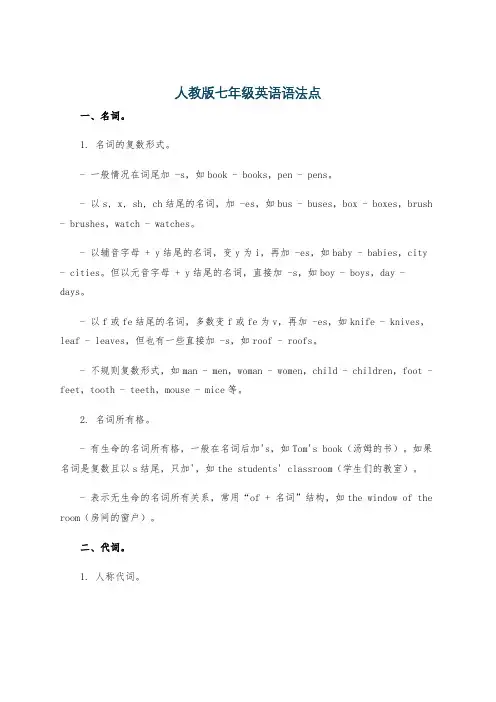
人教版七年级英语语法点一、名词。
1. 名词的复数形式。
- 一般情况在词尾加 -s,如book - books,pen - pens。
- 以s, x, sh, ch结尾的名词,加 -es,如bus - buses,box - boxes,brush - brushes,watch - watches。
- 以辅音字母 + y结尾的名词,变y为i,再加 -es,如baby - babies,city - cities。
但以元音字母 + y结尾的名词,直接加 -s,如boy - boys,day - days。
- 以f或fe结尾的名词,多数变f或fe为v,再加 -es,如knife - knives,leaf - leaves,但也有一些直接加 -s,如roof - roofs。
- 不规则复数形式,如man - men,woman - women,child - children,foot - feet,tooth - teeth,mouse - mice等。
2. 名词所有格。
- 有生命的名词所有格,一般在名词后加's,如Tom's book(汤姆的书)。
如果名词是复数且以s结尾,只加',如the students' classroom(学生们的教室)。
- 表示无生命的名词所有关系,常用“of + 名词”结构,如the window of the room(房间的窗户)。
二、代词。
1. 人称代词。
- 主格:I(我),you(你/你们),he(他),she(她),it(它),we(我们),they(他们/她们/它们)。
主格在句中作主语,如I like English.(我喜欢英语。
)- 宾格:me(我),you(你/你们),him(他),her(她),it(它),us (我们),them(他们/她们/它们)。
宾格在句中作宾语,如He helps me.(他帮助我。
)2. 物主代词。
七年级英语语法汇总
一、不定式和动名词:1、省略了to的不定式:(助动词后面加动词原形)have sb. do sth. let sth. make sb. do sth. help sb. do sth./help sb. with sth. can/may/have to/must do sth. see sb do sth(看见某人做某事,看见全过程,类似的还有:hear sb do sth , watch sth , find sb. do sth., notice sb. do sth 等)2、带to的不定式:want to do sth. want sb. to do sth. ask sb. to do sth. decide to do sth would like to do sth. hope to do sth.like to do sth(一般指一次性的行为) love to do sth. remember to do sth(记得去做某事,此事还未做) stop to do sth(停下来去做某事,此事是即将要做的事)3、带to的不定式可以作后置定语,如:something to eat(吃的东西)4、不定式表目的:如To save class time, our teacher has us do half of the exercises in class and complete the other half for our homework. 为了节约课堂时间,我们的老师要求我们在课堂上做一半练习,剩下的一半在课后作为家庭作业完成。
注意:for也可表目的,但for后面加名词或动名词,如I buy it for you.5、动名词:(介词后面加名词或动名词)have fun doing sth. practice doing sth. enjoy doing sth. what/how about doing sth. be busy doing sth.spend time doing sth. be good at doing sth.(be good at sth.) like doing sth(经常性的行为,习惯爱好)remember doing sth(记得做过某事,此事已经做了) stop doing sth(停止做某事,此事是要停止的)see sb doing sth(看见某人正在做某事,类似的有:hear sb doing sth , watch sth , find sb. doing sth., notice sb. doing sth)No talking(与之类似的:No swimming , No smoking等) thanks for doing sth.二、冠词不定冠词:a , an 可数名词前可以加a 或an。
2024年初一(七年级)人教版英语语法知识点
2024年初一(七年级)人教版英语语法知识点1.词性(1)名词(Nouns):表示人、地点、事物或概念。
分为可数名词与不可数名词单数与复数(例如:cat-cats,water-不可数)(2)动词(Verbs):表示动作或状态。
分为实义动词与助动词动词的时态(一般现在时、一般过去时、将来时)(3)形容词(Adjectives):描述名词的性质或状态。
比较级与最高级(例如:big-bigger-biggest)(4)副词(Adverbs):描述动词、形容词或其他副词的方式、程度等。
(5)频率副词(如always,usually,sometimes,never)2.句子结构(1)简单句(Simple Sentences):只有一个主语和一个谓语的句子。
例如:I like ice cream.(2)并列句(Compound Sentences):由两个或多个简单句通过连词连接而成。
例如:I like ice cream,and she likes cake.(3)从句(Complex Sentences):包含一个主句和一个或多个从句。
例如:I will go to the park if it is sunny.3.时态(1)一般现在时(Simple Present Tense):表示习惯或经常发生的动作。
结构:主语+动词原形(第三人称单数加-s)例如:He plays football.(2)一般过去时(Simple Past Tense):表示过去发生的动作。
结构:主语+动词的过去式例如:They visited the museum.(3)将来时(Future Tense):表示将要发生的动作。
结构:主语+will+动词原形例如:She will go to school tomorrow.4.疑问句和否定句疑问句(Questions):一般疑问句:助动词+主语+动词原形例如:Do you like pizza?特殊疑问句:疑问词+助动词+主语+动词原形例如:What do you want to eat?否定句(Negative Sentences):结构:主语+助动词+not+动词原形例如:I do not like spinach.5.代词人称代词(Personal Pronouns):I,you,he,she,it,we,they物主代词(Possessive Pronouns):mine,yours,his,hers,its,ours, theirs反身代词(Reflexive Pronouns):myself,yourself,himself,herself, itself,ourselves,yourselves,themselves6.介词表示时间的介词:in,on,at例如:I was born in2005.表示地点的介词:in,on,under,between,behind 例如:The cat is under the table.7.连词并列连词:and,but,or从属连词:because,although,if,when8.常用短语表示喜欢或不喜欢的表达:I like/I don’t like...My favorite...is...表示能力的表达:I can/I can’t...9.常见错误注意主谓一致:如第三人称单数加-s。
最全的人教版七年级英语语法总结(最新整理)
最全的⼈教版七年级英语语法总结(最新整理)七年级语法总结1、⽬前所学的动词的形式有4 种:①动词原形;如:do;have;like②动词的单三式(常在动词原形后加s);如:get-gets③动词不定式(to+动词原形);如:meet-to meet④动词ing式(动词原形后加ing)如:look-looking2、表⽬征求意见或建议邀请的礼貌⽬语Would you like +to+动词原形? (你想要……吗?)How about+动词ing ?(……怎么样?……好不好?)What about +动词ing? (……怎么样?……好不好?)Why not +动词原形? (为什么不……呢?)Why don’t you +动词原形?(你为什么不……呢?)Let’s +动词原形.(让我们……吧。
)表⽬同意、答应:①Yes,I’d like to./Oh,I’d love to.②All right/OK.③Great!④Sure.⑤Good idea!⑥Thanks.I’ll be glad to ⑦Thanks.That would be very nice.⑧I’d l ike that. 表⽬不同意、拒绝:①No,thanks.②Sorry,I can’t.③I’d like to.But I’m afraid I can’t/I have no time.3、⽬前学过的情态动词有can, may,could,would和will等五个。
学好情态动词必须把握三个⽬法:①后必须跟动词原形;②没有三单式(其后不能加s);③可以把情态动词提到句⽬构成疑问句;可以在情态动词后⽬加上not构成否定句。
4、⽬前学过的后跟动词不定式(to+动词原形)的有:①would like to+动词原形(想要做某事);want to+动词原形(想要做某事);②forget to+动词原形(忘记要做某事);③like to +动词原形(喜欢做某事);love to +动词原形(喜欢做某事)④ask sb. to +动词原形.(请/叫某⽬做某事)tell sb. to +动词原形.(告诉/叫某⽬做某事)would like sb. to +动词原形.(想叫某⽬做某事)want sb. to +动词原形.(想叫某⽬做某事)⑤have to +动词原形(必须/不得不做某事)⑥Nice/Glad/happy to +动词原形(很⽬兴做某事)如:Nice to meet you.I’m glad to be here.5、⽬前学过的后跟动词原形的有:①情态动词:can,may,could,would,will后;②助动词do,don’t,does,doesn’t后(does,doesn’t⽬出现,三单式要滚蛋);③动词please(请)后:如:Please tell him about the picnic.④短语Why not…/Why don’t you…后;⑤动词let 后;如:Let Jane help you. Let’s go home.⑥动词help后,也可带to;如:Let’s help Maria (to) carry water.⑦祈使句以动词原形开头,如:Have a seat , please.请坐下。
最新英语人教版七年级上册全册重点句型语法
最新英语人教版七年级上册全册重点句型语法1. 主语 + be动词 + 宾语- 例句:I am a student.- 翻译:我是一个学生。
2. 主语 + be动词 + 形容词- 例句:She is tall.- 翻译:她个子高。
3. 主语 + be动词 + 名词- 例句:They are teachers.- 翻译:他们是老师。
4. 主语 + be动词 + 地点- 例句:We are at school.- 翻译:我们在学校。
5. 主语 + be动词 + 时间- 例句:He is in the classroom at 8 o'clock. - 翻译:他在八点钟在教室里。
6. 主语 + be动词 + 副词- 例句:I am here.- 翻译:我在这里。
7. 主语 + have + 名词- 例句:We have a book.- 翻译:我们有一本书。
8. 主语 + have + 动词过去分词- 例句:He has finished his homework.- 翻译:他已经完成了他的作业。
9. 主语 + have + to + 动词原形- 例句:They have to study for the test.- 翻译:他们必须为考试研究。
10. 主语 + can + 动词原形- 例句:She can swim.- 翻译:她会游泳。
11. 主语 + can + 动词原形 + 物品- 例句:We can ride bicycles.- 翻译:我们会骑自行车。
12. 主语 + can't + 动词原形- 例句:He can't speak Chinese.- 翻译:他不会说中文。
13. 主语 + like + 名词/动词/动词-ing- 例句:They like basketball.- 翻译:他们喜欢篮球。
14. 主语 + don't/doesn't + like + 名词/动词/动词-ing - 例句:She doesn't like swimming.- 翻译:她不喜欢游泳。
- 1、下载文档前请自行甄别文档内容的完整性,平台不提供额外的编辑、内容补充、找答案等附加服务。
- 2、"仅部分预览"的文档,不可在线预览部分如存在完整性等问题,可反馈申请退款(可完整预览的文档不适用该条件!)。
- 3、如文档侵犯您的权益,请联系客服反馈,我们会尽快为您处理(人工客服工作时间:9:00-18:30)。
一、不定式和动名词:1、省略了to的不定式:(助动词后面加动词原形)have sb. do sth. let sb.do sth. make sb. do sth. help sb. do sth./help sb. with sth. can/may/have to/must do sth. see sb do sth (看见某人做某事,看见全过程,类似的还有:hear sb do sth , watch sb.do sth , find sb. do sth., notice sb. do sth等)2、带to的不定式:want to do sth. want sb. to do sth. ask sb. to do sth. decide to do sth would like to do sth. hope to do sth.like to do sth(一般指一次性的行为)love to do sth. remember to do sth(记得去做某事,此事还未做)stop to do sth(停下来去做某事,此事是即将要做的事)3、带to的不定式可以作后置定语,如:something to eat(吃的东西)4、不定式表目的:如To save class time, our teacher has us do half of the exercises in class and complete the other half for our homework. 为了节约课堂时间,我们的老师要求我们在课堂上做一半练习,剩下的一半在课后作为家庭作业完成。
注意:for也可表目的,但for后面加名词或动名词,如I buy it for you.5、动名词:(介词后面加名词或动名词)have fun doing sth. practice doing sth. enjoy doing sth. what/how about doing sth. be busy doing sth.spend time doing sth. be good at doing sth.(be good at sth.) like doing sth(经常性的行为,习惯爱好)remember doing sth(记得做过某事,此事已经做了)stop doing sth(停止做某事,此事是要停止的)see sb doing sth(看见某人正在做某事,类似的有:hear sb doing sth , watch sb.doing sth , find sb. doing sth., notice sb. doing sth)No talking(与之类似的:No swimming , No smoking等)thanks for doing sth.二、冠词不定冠词:a , an 可数名词前可以加a 或an。
以元音(不是元音字母)开头的名词前加an,以辅音开头的名词前加a 如:a uniform an hour There is a “u” and an “n” in the word.定冠词:the,有指定性的名词前加the,前文出现过再次出现时前面也加the注意:物主代词后面不加冠词(my home);某些名词前不加冠词(如国家,城市,有名字的街道,三餐,具体的年份和月份等);球类运动前不加the,而乐器前要加the。
含冠词的短语:on weekends 和on the weekend,take a bus/taxi/walk,take a photo和take photos,go to a movie和go to the movies,havea look,have a walk,have a rest,have a good time,in the neighborhood等。
三、介词(后加名词或动名词,还可组成固定短语。
但注意:home , here , there ,today, tomorrow, yesterday等词除固定短语外前面不加介词;由this, that ,these, those,each, any, every, some, all等用于表示时间概念的名词前往往不加介词。
)1、介词in表示一天中某段时间,指天、年、月、季节、周次等。
如:in the morning表示“在……里面”the window is in the wall , I sit in the chair. He is in the red shirt. The bird is in the tree.表示“排、行、组,前、后”,如:We are in Team One. in front of(在前面),in the front of (在前部)表示较大的地方,如大城市、国家、洲等,如:He lives in Beijing. arrive in Yueyang表示“包含”如:Beijing is in the north of China. 表示“用材料、语言”如:Can you say it in English? What’s this in English?2、介词on用来表示某一天或星期几,指明具体的某一天。
如:on a rainy day表示一物放在另一物上面,两者紧贴在一起,如:The book is on the table. The apple is on the tree.(树的一部分)在…队里用on,如:on the basketball team 表示“左、右”,如:Li Ping is on my left.用于路名,如:He lives on Nanjing Road. 表示“紧邻”如:Canada lies on the north of the U.S.3、介词at表示特定的时间、节日、年龄等(具体的,小的时间)。
如:at noon , at 6 am表示较小的地方,如家、村、乡村等,如:He lives at a small village. 用于门牌号,如:He lives at No.200, Nanjing Road.4、介词for表示“当作、作为”。
如: I like some bread and milk for breakfast. 我喜欢把面包和牛奶作为早餐。
表示理由或原因,意为“因为、由于”。
如:Thank you for helping me with my English. 谢谢你帮我学习英语。
表示动作的对象或接受者,意为“给……”、“对…… (而言)”。
如: Let me pick it up for you. 让我为你捡起来。
表示时间、距离,意为“计、达”。
如: I usually do the running for an hour in the morning. 我早晨通常跑步一小时。
表示以具体价格购买。
如:You can take it for 5 yuan each.5、介词under表示“在…下方”(不接触),如:They were seen under the tree.6、介词across着重于“从一头或一边到另一头或另一边”,强调从表面穿过。
如:She went across the street to make some purchases.7、介词through着重于“穿越”,强调从一定的空间内穿过。
如:The sunlight was coming in through the window.8、介词to表示向某处移动,如:go to school , get to school9、介词with表示“用工具、某物”如:with a pen 还可表示“和…..一起”He with his parents is watching TV.10、介词by表示“用、以、靠、通过…方法”如:He prefers traveling by car.11、介词between 表示“在两者之间”如:Don’t sit between the two girls.四、词语1、常见短语a set of 一套lost and found 失物招领in English 用英语first name 名字family/last name 姓氏family tree 家谱Dave’s family/the Daves 大卫一家my family photo/a photo of my family 我的一张全家福take…to…把…带到…去bring …to…把…拿到….来play volleyball/basketball/tennis/chessplay computer games 玩电脑游戏play sports 做运动play the guitar/the piano/the drum on TV 在电视上 a lot 非常 a lot of/lots of(后加名词)许多watch TV 看电视watch the match 观看比赛every day 每天everyday 日常的ice cream 冰淇淋French fries 炸薯条healthy food 健康食品a running star 跑步明星make a list 列个清单have/eat breakfast/lunch/dinner吃早餐/中餐/晚餐have/eat …for breakfast 早餐吃…let’s=let us 让我们…how about/what about …怎么样how much 多少钱what color 什么颜色at a (very)good price 以优惠的价格have a look (at) 看一看date of birth出生日期want (sb.)to do sth. 想要(某人)做某事for sale 待售on sale 降价出售in October 在十月on Octorber tenthhappy birthday 生日快乐two years old 两岁t wo-year-old 两岁的school trip 学校旅行社Art Festival 艺术节speech contest 演讲比赛English party 英语晚会School Day 校庆what kind of 哪种…Beijing Opera 京剧go to a movie/go to the movies/see a movie/go to see a movie 去看电影院go to work 去上班go to school 去上学go home 回家go to the mountains 去爬山go shopping/swimming/skating/hiking/sightseeing 去购物/游泳/滑冰/徒步旅行/观光go to bed 去睡觉be in bed 入睡get up 起床get to school 到学校get home 到家learn/know about 了解Chinese history 中国历史on weekends/on the weekend 在周末speek English 讲英语science teacher科学老师join the art club/the swimming club 加入艺术俱乐部/游泳俱乐部call sb. at….拨…号码找某人what time(具体)什么时候be good with sb. 相某人相处得好be good at sth/doing sth 擅长于某事/做某事brush one’s teeth刷牙 a few of 一点儿a little of 一点儿(加不可数名词)a little 一点儿kind of 有点 a little bit 有点 a kind of 一种all kinds of 各种各样的take a shower 淋浴after breakfast早餐后do one’s homework 做家庭作业help sb. with sth/help sb. do sth. 帮助某人干某事all night整夜in the morning/afternoon evening在上午/下午/晚上at noon/ night 在中午/晚上best wishes(to you)最好的祝愿tell sb. about sth.告诉某人关于某事your favorite subject 你最喜欢的科目have math/music上数学课/音乐课be tired 累after class 下课后after school 放学后Class 3 Grade 2 二年级三班at 6:00 am 在上午6点play with 和…一起玩have volleyball 打排球run around 到处跑pen pal 笔友be from/come from 来自于…live in 住在…. in China 在中国write to sb. 给某人写信post to sb. 寄给某人post office 邮局pay phone 投币式公用电话across from 在…对面next to 靠近in the neighborhood 附近between…and…在…和…之间in front of 在….前面队in the front of 在…前部go straight 直走go/walk down 顺着…走go through 经过turn left/right at 在…向左/右转on the right 在右边have fun/have a good time/enjoy oneself 玩得开心have a good trip 旅途愉快take a walk/bus/taxi 散步/乘巴士/乘出租车take a photo/take photos 拍照the beginning of …的开端keep/be quiet 安静in/during the day 在白天listen to 听look at 看shop assistant 店员bank clerk 银行职员TV station 电视台work with 和…一起工作go out 出去TV show 电视节目study/work hard 努力学习/工作give sb. sth./give sth. to sb.给某人某物get sth. from sb. 从某人那里得到某物not bad 不错work for sb. 为…效力talk to/with sb. 和某人交谈talk about sth. 谈论某事talk on the phone 打电话ask sb. to do sth.ask sb. sth. 问某人某事wait for 等候at school 在学校(学习)in school 在学校read books 看书on vacation 度假thank you for doing sth.谢谢你做某事thanks for 因…..谢谢你lie on the beach 躺在沙滩上play beach volleyballlook cool 看上去酷look like 看起来像pretty good 好极了long curly black hair 卷的黑色的长发medium height中等身高medium build 中等身材the captain of …的队长love to do sth. 喜爱做某事would like sth/to do sth. 想要某物/做某事like doing sth. 喜欢做某事stop doing sth.停止做某事tell jokes讲笑话pop singer 流行歌手what size 什么型号/尺寸beef and tomato noodles 牛肉西红柿面条orange juice 橘子汁green tea 绿茶stay at home 呆在家里all day 整天have a party举行晚会do some reading 阅读practice English 练习英语practice doing sth. 练习做某事talk show脱口秀study fo the test 准备测验last weekend 上周末clean one’s room 打扫房间go for a walk 去散步go on vacation去度假go to summer camp 去参加夏令营have fun doing sth. 做某事玩得高兴in the water 在水中in the corner 在角落walk back to 走回到…decide to do sth. 决定做某事the Great Wall 长城the Palace Museum 故宫Tian’anmen Squarethink of 认为,想到game show 比赛节目soap opera 肥皂剧sports shows 体育节目in fact 事实上in class 在课堂上in the hallways 在走廊里in the dining hall 在餐厅enjoy doing sth. 喜欢做某事arrive late for class 上课迟到go out 出去on school nights 在有课的晚上too many rules 太多规定make dinner 做晚饭the Children’s Palace 少年宫have to 不得不on one’s way home 在某人回家的路上on one’s way to 在某人去…的路上the way to 去…的路2、常见词的辨析(1)bring和take bring意为“拿来,取来,带来”,常和介词to连用;take意为“拿走,带走”。
